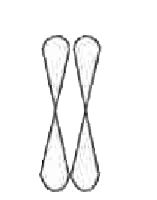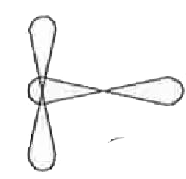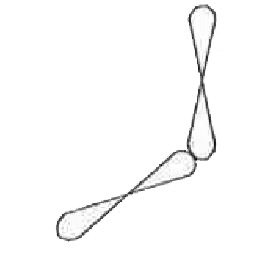Explore topic-wise InterviewSolutions in .
This section includes InterviewSolutions, each offering curated multiple-choice questions to sharpen your knowledge and support exam preparation. Choose a topic below to get started.
| 14301. |
Which is not the property of ethanenitrile (CH_(3)CN) |
|
Answer» Undergoes acidic hydrolysis to give carboxylic acid `CH_(3)CN` does not give carbylamine reaction with chloroform because it is not an amine. `CH_(3)CN` undergoes acidic hydrolysis to give carboxylic acid. `CH_(3)CNoverset(H_(2)O //H^(+))rarrCH_(3)CONH_(2)overset(H_(2)O //H^(+))rarrCH_(3)COOH+NH_(3)` `CH_(3)CN` undergoes alkaline hydrolysis to give salt of carboxylic acid. `CH_(3)CN` tautomerises to give methyl isocyanide `CH_(3)-C=NhArrC=N-CH_(3)` |
|
| 14303. |
Which occurs to minmum extent in nature |
|
Answer» `Ag_(2)S` |
|
| 14304. |
Which of the following gives ketone on oxidation |
|
Answer» `(CH_(3))_(3)COH` |
|
| 14305. |
Which of the following has the least boiling point ? |
|
Answer» n-Hexane |
|
| 14306. |
Which among the following can exhibit cis-trans isomerism |
|
Answer» `CoCl_(3).4NH_(3)` |
|
| 14307. |
Write the monomers of the following : (i) Teflon (ii) Cellulose (iii) Neoprene (iv) Polythene. |
Answer» SOLUTION :
|
|
| 14308. |
The the reaction CH_(3)CHOoverset(PCl_(5))rarrXoverset(aq.KOH)rarrY,Y is |
|
Answer» Ethyne |
|
| 14309. |
Which of the following is the weakest acid |
| Answer» SOLUTION :HF has high bond DISSOCIATION energy. | |
| 14310. |
Which of the following complex has the highest stability constant at 298 K |
|
Answer» `[Cdcl_(4)]^(2-)` Hence, (D) is the correct |
|
| 14311. |
What is the value equilibrium constant if E_(cell)^(@)=0? |
|
Answer» SOLUTION :`E^(@)=(0.0591)/(n)LOGK" or "=(0.0591)/(n)logK` `K=0 "or "K=" Anti " LOG 0=1`. |
|
| 14312. |
Write the structure of the main products of following reactions: |
Answer» SOLUTION : 
|
|
| 14313. |
What happens when ethanol is treated with conc. H_(2)SO_(4) at 443 K ? |
|
Answer» Solution :`C_(2)H_(4)` is obtained. `C_(2)H_(5)OH overset("Conc. "H_(2)SO_(4))UNDERSET(443 K)rarr C_(2)H_(4)+H_(2)O`. |
|
| 14314. |
Which compound will absorb the maximum amount of heat when dissolved in the same amount of water ? (Integral heats of solution at 25^(@)C in kcal/mol of each solute are given in brackets) |
|
Answer» `HNO_(3)(DeltaH=-33)` |
|
| 14315. |
Two containers are connected by stopcock as shown. If initially P_(O_(2))=P_(He)=P when stopcock is closed. Then after opening the stopcock (alter a long time keeping initial temperature in each same as initially). |
|
Answer» <P>`P_("final")=P` `n'_(1)+n'_(2)=n_(1)+n_(2)` `(P_(f)xx10)/(Rxx300)+(P_(f)xx20)/(Rxx600)=(Pxx10)/(300R)+(Pxx20)/(600R)` For `O_(2) & He` before MIXING `(P_(O_(2))V_(O_(2)))/(n_(O_(2))T_(O_(2)))=(P_(He)V_(He))/(n_(He)T_(He))` `T=T_(He)=600K` For `O_(2)` in `1^(st)` container and `2^(nd)` container its MOLE distribution `(Pxx10)/(Pxx20)=((n_(O_(2)))_(1)xxRxx300)/((n_(O_(2)))_(2)xxRxx600)` `(n_(O_(2)))_(1)=(n_(O_(2)))_(2)=(X)/(2)` Similarily `(n_(O_(2)))_(1)=(X)/(2)` Partial pressure of `O_(2)` in any container `P_(O_(2))=x_(O_(2))P_("total")` `P_(O_(2))=(X//2)/(X)P=(P)/(2)` Partial pressure of He in any container `P_(He)=P-P_(O_(2))=(P)/(2)` T=600K A,B,D |
|
| 14316. |
Which of the following is low spin complex |
|
Answer» `[NiCl_4]^(2-)` |
|
| 14317. |
What is saturated solution? |
| Answer» SOLUTION :A solution in which ono more solute can be DISSOLVED at the same TEMPERATURE and pressure is CALLED a saturated solution. | |
| 14318. |
Write electronic configuration, calculate magnetic moment and predict magnetic properties of some 3d element ions. |
Answer» SOLUTION :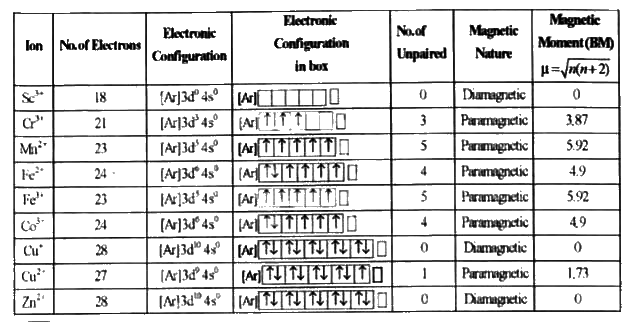
|
|
| 14319. |
What type of isomerism is exhibited by the complex [Co(en)_(3)]^(3+) ? (en = ethane-1, 2-diamine) |
| Answer» Solution :`[CO(en)_(3)]^(3+)` exhibits OPTICAL ISOMERISM. | |
| 14320. |
Whichg of the following hydrides has the lowest boiling point? |
|
Answer» `H_(2)O` `H_(2)S` has lowest boiling point and `H_(2)O` has HIGHEST boiling point because due to highest boiling point of `H_(2)O` is high. |
|
| 14321. |
When a solution of conductance 1.342 mho "metre"^(-1) was placed in a conductivity cell with parallel electrodes, the resistance was found to be 170.5 oh. The area of the electrodes is 1.86 xx 10^(-4) sq metre. Calculate the distance between the two electrodes in metres. |
| Answer» SOLUTION :`4.25 XX 10^(-2)` METRES | |
| 14322. |
Which one of the following anions is present in the chain structure of silicates? |
|
Answer» `(Si_(2)O_(5)^(2-))_(N)` |
|
| 14323. |
What is an adsorption isotherm? Discuss the phenomenon of adsorption of gases on solids with the help of Freundllich adsorption isotherm. |
|
Answer» Solution :Adsorption ISOTHERM: The variation in the amount of gas adsorbed by the adsorbent with pressure at constant TEMPRETURE can be expressed by means of a curve known as adsorption isotherm. `to` freundlich adsorption isotherm equation is `(x)/(m)=k,p^(l//n)` x=mass of the gas adsorbed m= massof the adsorbent p,k and n are constansts. `to`k and n depend on the nature of the adsorbent and the gas at a paraticular tempreture . `to` The relation ship is genrally represnted in the from of a curve where x/m is PLOTTED against pressure. `to`These curves indicate that a fixed pressure there is a decrease in physical adsroption with rise of TEMPRATURE. `(x)/(m)=k.p^(1//4)` Applying logarithm `Log ""(x)/(m) = log K + (1)/(n) log P` `to` The validity of Freumdllich isotherm can be verified by plotting log`(x)/(m)`on y-axis and log p on x-axis. If is a straight LINE thenthe isothern is valid. `to` The slope of the straight line give the value of `1/n` `to` The intercept on the y-axis the value of log K. 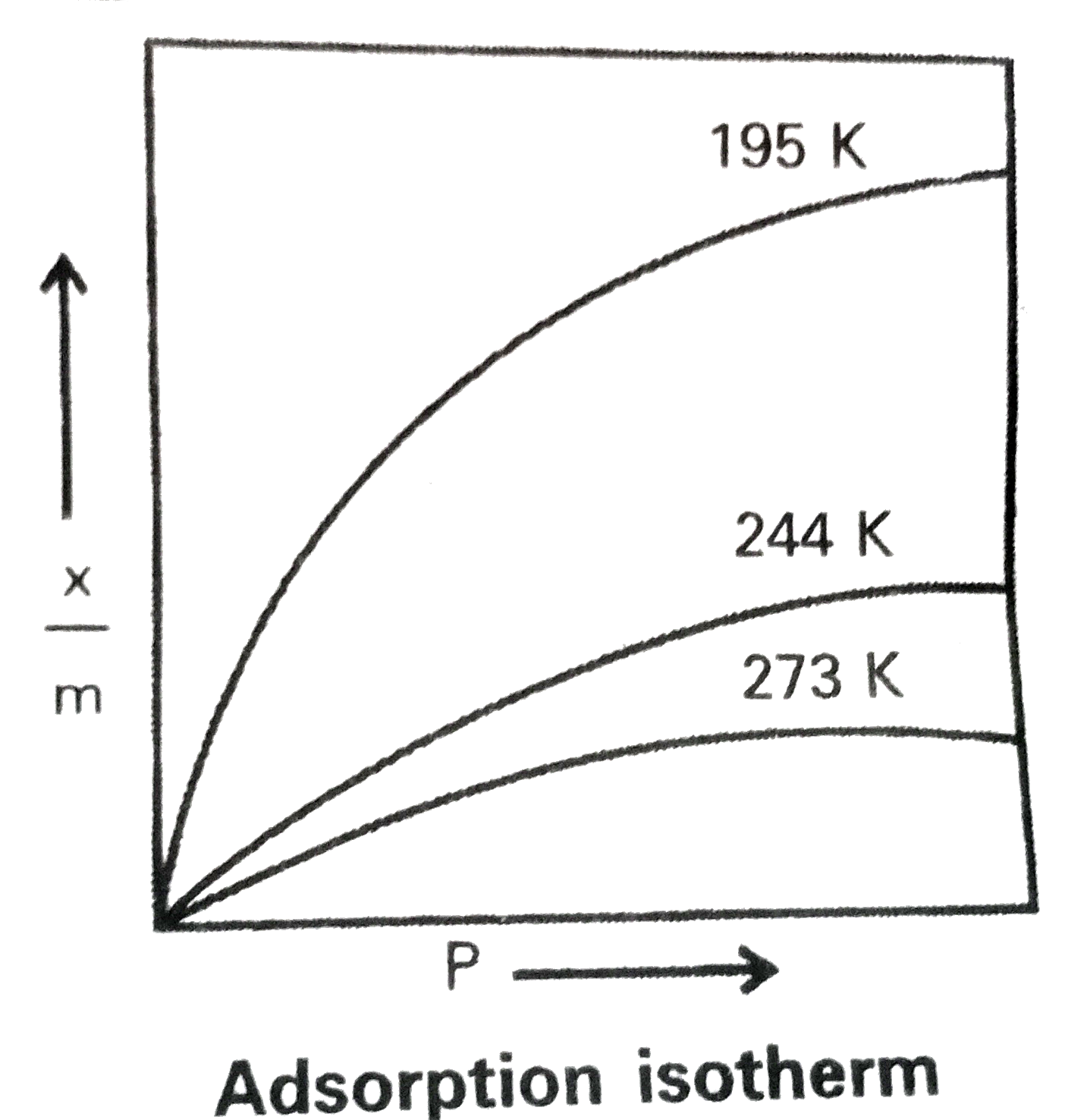 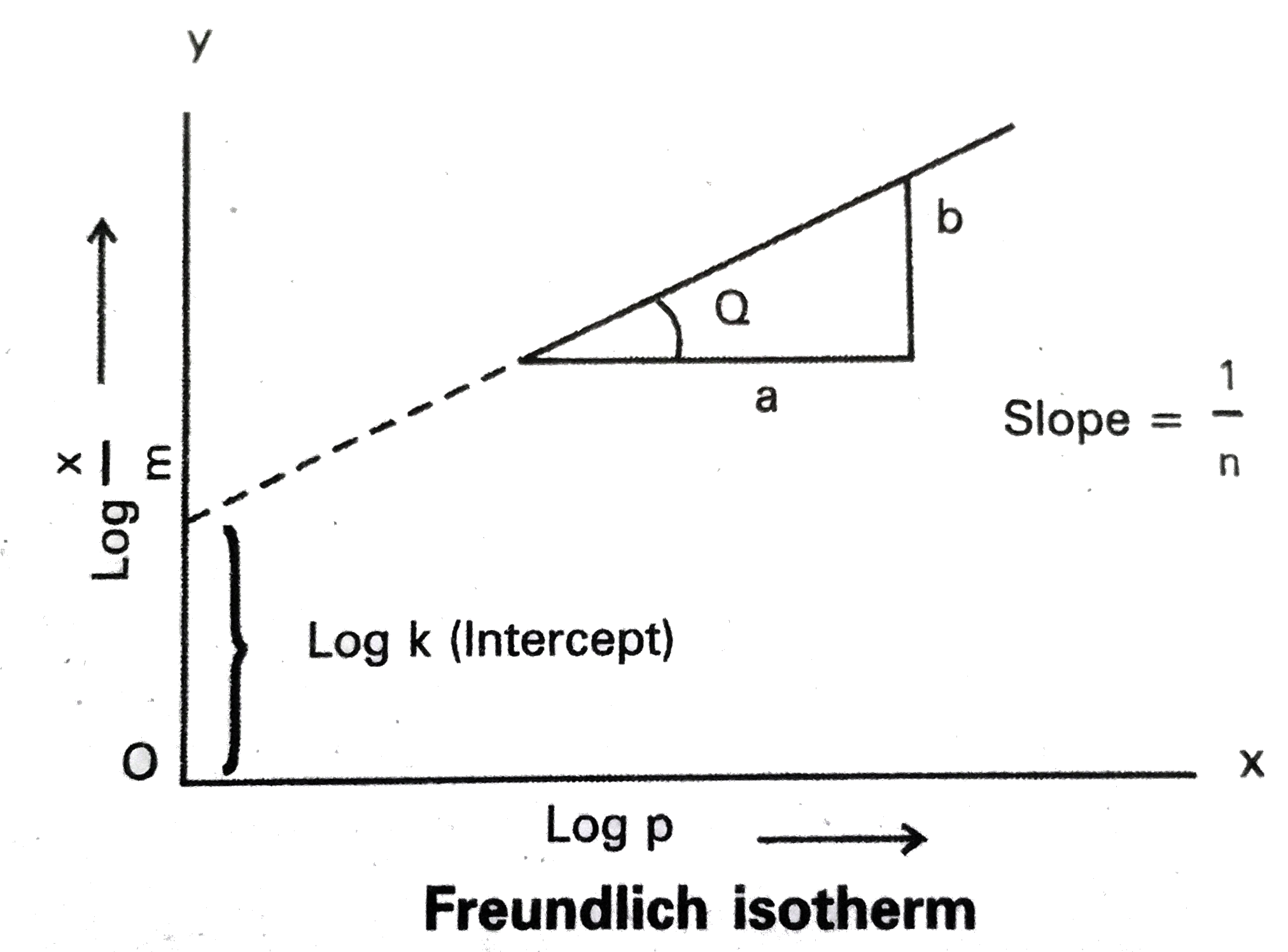
|
|
| 14324. |
The secondary valence of Pt^(4+) is six. Calculate the number of moles of AgCl participated, when excess of AgNO_3 solution is added to 2L of 0.1M PtCl_4. 4NH_3solution. |
|
Answer» Solution :Secondary valence of `Pt^(4+)` is six and it will be SATISFIED by four `NH_(3)` and two `CI^(-)` IONS. The remaining two `CL^(-)` ions satisfy only primary valence. `PtCl_(4).4NH_(3)` can be written as `[Pt(NH_(3))_(4)Cl_(2)]Cl_(2)`. One mole of this complex GIVES 2 moles of chloride ions in the aqueous solution. Number of moles of complex present in 2L of 0.1M `PtCl_(4).4NH_(3)=MxxV=0.1xx2=0.2` Number of moles of chloride ions present in 2L of 0.1M `PtCl_(4).4NH_(3)` solution `= 2 xx0.2 = 0.4`. Number of moles of AgCl precipitated from 2L of 0.1 M `PtCl_(4).4NH_(3)` is 0.4. |
|
| 14326. |
Which allotrope of sulfur exists in the form of zig-zag chains of sulfur atoms? |
| Answer» SOLUTION :PLASTIC SULFUR | |
| 14327. |
Write IUPAC name of [Pt(NH_(3))_(2)Cl_(2)]. |
| Answer» SOLUTION :diamminedichloridoplatinum (II). | |
| 14328. |
Which of the following is correct about lyophillic sol? |
|
Answer» They are irreversible |
|
| 14329. |
Which is used to preserve biological specimens ? |
|
Answer» Acetone |
|
| 14330. |
Which one of the following process is used to distinguish between the three types of alcohols? |
|
Answer» Reduction |
|
| 14331. |
Which of the following is/are not lyophobic in nature? |
|
Answer» `AS_(2)S_(3)` |
|
| 14332. |
Using option how many total number of statements are correct. (I) H-bond is also a one type of dipole-dipole interaction. (II) Hybrid orbital always form sigma bond (III) If molecule is polar then it must be planar. (IV) If bond is polar then compound must be polar. (V) In chloral hydrate molecule intramolecular H-bond is present. (VI) More electronegati ve element alswayshas more electron affinity (VII) Hardness present in water is due to presence of D_(2)O. (VIII) Order of boiling point H_(2)ltD_(2)ltT_(2). (IX) |
| Answer» Solution :(I) TRUE (II) False (III) False (IV) False (V) True (VI) False (VII) False (VIII) True (IX) True | |
| 14333. |
Which of the followingis incorrect combination ? |
| Answer» Solution :N/A | |
| 14334. |
Which of the following does NOT result in increase in the entropy? |
|
Answer» CRYSTALLIZATION of SUCROSE from solution |
|
| 14335. |
What is the oxidation potential of given hydrogen half cel at 1 bar pressure and 25^(@)C temperature? Pt|underset("1 bar")(H_(2(g)))|HCl_((aq))pH=3 |
|
Answer» `0.059V` So, `[H^(+)]=1xx10^(-3)M=0.001M` And reaction : `underset("1 bar")(H_(2(g))) to underset(0.001M)(2H_((aq))^(+))+2e` According to Nernest.s formula, `E_(CELL)=E_(H^(+)//H_(2))^(Theta)-(0.059)/(n)"log"([H^(+)]^(2))/([H_(2)])` `=0.0-(0.059)/(2)"log"((0.001)^(2))/(1)` `=0.0295xx(-6.0)` `=+0.177V` |
|
| 14336. |
Whichof thefollowingisomericheptanes canyieldsevendiffernetmonochlorinatedproducts upon free radicalchorination ? |
|
Answer» 2,3 Dimethypentane |
|
| 14337. |
Which one of following undergoes reaction with 50% sodium hydroxide solution to give the corresponding alcohol and acid ? |
|
Answer» Phenol |
|
| 14338. |
Write expression for half-life in case of a reaction between hydrogen and chlorine to form hydrochloric acid gas. |
| Answer» SOLUTION :Given reaction is a reaction of ZERO order. HENCE, `t_(1//2)=[A]_(0)//2" K (page 4/24)".` | |
| 14339. |
Which of the following metal is thrown as anode mud during electrolytic refining of copper? |
|
Answer» Zn |
|
| 14340. |
Which can be used to prepare methane? |
|
Answer» CLEMMENSEN reduction |
|
| 14341. |
Which of the following halogens has basic properties : |
|
Answer» Fluorine |
|
| 14342. |
Which one of the following complex ions has geometrical isomers? (en = ethylenediamine) |
|
Answer» `[Ni(NH_(3))_(5)Br]^(+)` 
|
|
| 14343. |
Which of the following is incorrect? 1) Catalyst undergoes permanent chemical change 2) Particle size of solute in true solutions is 10^(3-)m 3) Starch solution is a hydrosol 4) Hydrolysis of liquid ester in the presence of mineral acid is an example of heterogeneous catalysis reactions |
|
Answer» 1, 2 and 3 |
|
| 14344. |
When 1.0 g of a non-volatie solute was dissolved in 10 g benzene, elevation in boiling point temperature was found to be 1^(@)C. Calculate the molar mass of the dissoved substance. (K_(b) "for benzene = 2.53 K kg" mol^(-1)). |
|
Answer» `DeltaT_(b)=1^(@)C or 1 K, K_(b)=2.53" K kg MOL"^(-1)` `M_(B)=(K_(b)xxW_(B))/(DeltaT_(b)xxW_(A))=((2.53" K kg mol"^(-1))xx(1.0 G))/((1 K)xx(0.01" kg"))=253" g mol"^(-1)` |
|
| 14345. |
The total number of Aldols (beta-Hydroxy carbonyl compounds) are formed in te following reaction. (ignore stereoisomers) PhCHO+CH_(2)CH=O+Ph-underset(O)underset(||)C-CH_(3)overset(Dil.NaOHDelta)to |
|
Answer» Solution :`PhCHO+CH_(3)CH=)+Ph-underset(O)underset(C)-CH_(3)overset(DIL NAOH,DELTA)to` Total 6 aldol products |
|
| 14346. |
underset("monochlorination")overset(Cl_2,hv)toA=no . Of total monochloroproducts (with stereo isomers). |
Answer» 
|
|
| 14347. |
Which alkali metal is most metallic in character |
|
Answer» Li |
|
| 14348. |
Write the structural formula and IUPAC names of all isomeric amines with molecular formula C_3 H_9 N. Which out of these will give carbylamine reaction ? |
|
Answer» SOLUTION : The three isomeric amines are: (i) `CH_3CH_2CH_2 NH_2` (1-Propanamine) (ii) `CH_3NHC_2H_5`(N-Methylethanamine) (iii)`(CH_3)_3N` (N, N-Dimethylmethanamine) Only 1-propanamine (`1^@`amine) will give carbylamine reaction. |
|
| 14349. |
Tranquilizers affect |
|
Answer» stomatch |
|
| 14350. |
The van't Hoff 's factor (i) for a 0.2 molal aqueous solution of urea is |
|
Answer» `0.2` |
|
